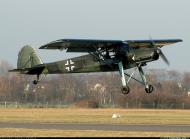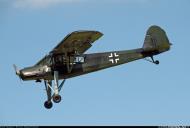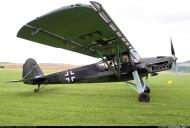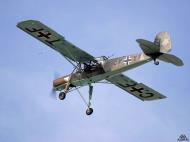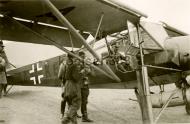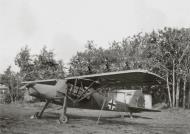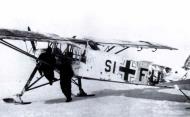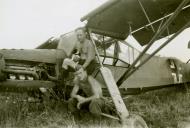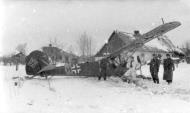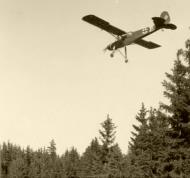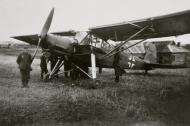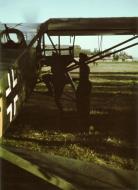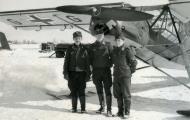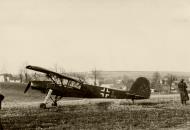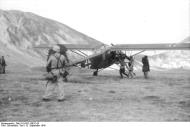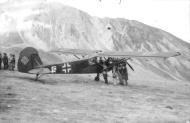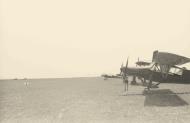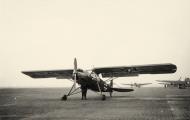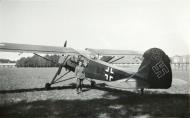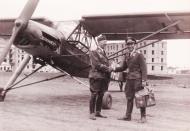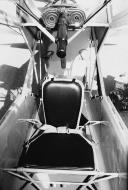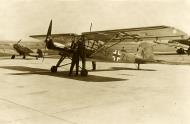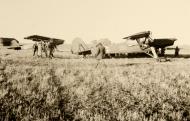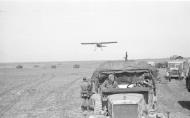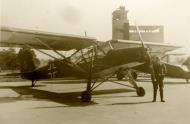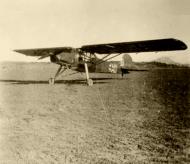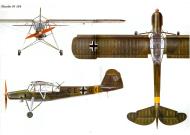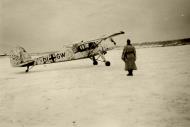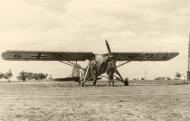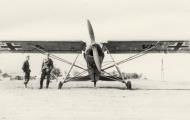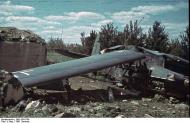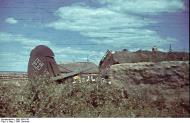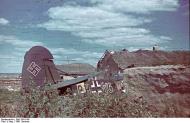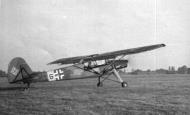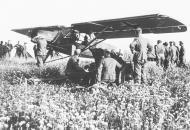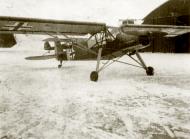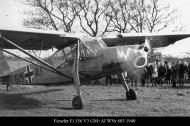Fieseler Fi 156 Störch (Stork) various wartime photographs
Fieseler Fi 156 3./JG54 Russia 1941 01
Photo 01: This is a photograph of a Luftwaffe Aufklarer German Reconnaissance Fieseler Fi-156C Störch (Stork) operated by III./JG54 seen in the Summer of 1941 is marked with the Geschwader and Gruppe emblems. Other communications and courier aircraft used on the Eastern Front included the the Messerschmitt Bf-108.
Fieseler Fi 156 3./JG54 Russia 1941 02
Photo 02: This is a photograph of a Luftwaffe Aufklärer German Reconnaissance Fieseler Fi-156C Störch (Stork) seen in the Summer of 1941.
Fieseler Fi 156 Stkz SIFU East Prussia 1944 01
Photo 02: This is a photograph of a Luftwaffe Aufklarer German Reconnaissance Fieseler Fi-156C Störch (Stork) coded (SI+FU) seen here in the bitter winter of 1944-45 in East Prussia, this Fieseler Fi 156C-2 has had its winter camouflage applied thickly around the centre fuselage; everywhere else it is wearing away to reveal the 70/71 camouflage beneath. Oddly, despite the late date in the war, the marking, are the same as two years earlier. The last two letters of the code have apparently been re-applied at some point out of alignment with the rest. Note also that the yellow fuselage hand is also flaking away.
Fieseler Fi 156 Stammkennzeichen code CBGF 01
Photo 01: This photo is of a Fieseler Fi-156D-1 warbird (MS500 c/n 340) restored at Newburyport, Massachusetts during 1973 and was coded (CB+GF) and painted in desert colors.
Fieseler Fi 156 Stammkennzeichen code CEGX Eastern Front 1943 00
Profile 00: This is a profile of a Luftwaffe Aufklarer German Reconnaissance Fieseler Fi-156C-3 Störch (Stork) coded CE+GX and operated in the Eastern Front 1943. Without doubt, the Fiesele. Storch was the prime example of an army co-operation and observation aircraft, and certainly the design by which other types operating in these roles were judged. This anonymous Fi-156C-3, which retains four-letter factory codes instead of any unit identification, clearly illustrates the purposeful design of the undercarriage with the long compression legs incorporating long stroke, oil-damping shock absorbers capable of coping with very high vertical descent rates. Such was the success of the Storch in its intended role that trials were conducted around supply-dropping, coastal patrol and light bombing roles, although only as secondary operations
Fieseler Fi 156 Stammkennzeichen code CFTF 01
Photo 01: This photo is of a Fieseler Fi 156 Storch warbird coded (CF+TF) http://www.airliners.net
Fieseler Fi 156 Stammkennzeichen code CFTF 01
Photo 01: This photo is of a Fieseler Fi 156 Storch warbird coded (CF+TF) http://www.airliners.net
Fieseler Fi 156 Stammkennzeichen code GATZ Eastern Front
Fieseler Fi 156 (H3BF) Stavanger Forus 1943 01
Photo 01: This is a photograph of a Luftwaffe Aufklarer German Reconnaissance Fieseler Fi-156C-5 Störch (Stork) liaison plane of Stab Jafü/Norwegen coded H3+BF at Stavanger Forus in December 1943.
Fieseler Fi 156 Stammkennzeichen code THAF Field Marshal Erwin Rommel's aircraft North Africa 1941 01
Photo 01: This IL2 skin profile is of a Fieseler Fi 156 Storch (Stork) coded (TH+AF).
Fieseler Fi 156 Stammkennzeichen code THAZ North Africa 1941 01
Photo 01: This IL2 skin profile is of a Fieseler Fi 156 Storch (Stork) coded (TH+AZ).
Airworthy Fieseler Fi 156C7 Storch EV+DB warbird with German civil registration D-EVDB 01
Airworthy Fieseler Fi 156C7 Storch EV+DB warbird with German civil registration D-EVDB 02
Airworthy Fieseler Fi 156C7 Storch EV+DB warbird with German civil registration D-EVDB 03
Airworthy Fieseler Fi 156 Storch Stkz CF+TF warbird 01
Airworthy Fieseler Fi 156 Storch warbird as VS53 B1+BB with FAA civil registration NX156FC 01
Airworthy Fieseler Fi 156 Storch warbird as VS53 B1+BB with FAA civil registration NX156FC 02
Arado Ar 66C Lufwaffe Stkz NKAY later NSGr8 at Malmi 29th Jan 1944 01
Arado Ar 66C Lufwaffe Stkz NKAY later NSGr8 at Malmi 29th Jan 1944 02
Arado Ar 66C Lufwaffe Stkz NKAY later NSGr8 at Malmi 29th Jan 1944 03
Arado Ar 66C Lufwaffe Stkz NKAY later NSGr8 at Malmi 29th Jan 1944 04
Arado Ar 66C Lufwaffe Stkz NKAY later NSGr8 at Malmi 29th Jan 1944 05
Artwork showing a cut away 3D dimensional diagram Fieseler Fi 156 Storch 0A
Fieseler Fi 156C2 Storch Stkz NAKE WNr 4410 with a high ranking German Officer Norway 1940 ebay 01
Fieseler Fi 156C2 Storch Stkz SIFU East Prussia 1944 01
Fieseler Fi 156C2 Storch Stkz SIxx heavily landed Ostfront ebay 01
Fieseler Fi 156C3 Storch Stkz PVZF WNr 5303 landed Ostfront 1942 ebay 01
Fieseler Fi 156C3Trop Storch Stkz GFYx Russia 01
Fieseler Fi 156C3Trop Storch Stkz GFYx Russia 02
Fieseler Fi 156C3Trop Storch Stkz GFYx Russia 03
Fieseler Fi 156C3Trop Storch Stkz GGMP WNr 5380 flown by Hotmann 1941 42
Fieseler Fi 156C3Trop Storch Stkz KNLK WNr 5516 ebay 01
Fieseler Fi 156C Storch Czechoslovakia made version Mraz K.65 Cap Northern Bohemia 1957 01
Fieseler Fi 156C Storch during the Balkans campaign 1941-42 NIOD
Fieseler Fi 156C Storch Stkz DBZY at a major Luftwaffe base ebay 01
Fieseler Fi 156C Storch Stkz xxKS landed in Paris after France surrendered 1940 01
Fieseler Fi 156 Storch 4th Panzer Div nosed over Polish campaign 1st Sep 1939 ebay 01
Fieseler Fi 156 Storch coded QK in winter camouflage and using skies Russia 0A
Fieseler Fi 156 Storch factory fresh being fueled ebay 01
Fieseler Fi 156 Storch internal photo inside cockpit 01
Fieseler Fi 156 Storch internal photo inside gunners seat 01
Fieseler Fi 156 Storch internal photo inside rear gun 01
Fieseler Fi 156 Storch Luft Beob Staffel 4 Transportstaffel 40 6FZL Italy 1941 42 ebay 01
Fieseler Fi 156 Storch most likely on a clandestine mission ebay 01
Fieseler Fi 156 Storch OKH Chief of Staff Heinz Guderian Germany 1945 01
Fieseler Fi 156 Storch parked at a main airport early war ebay 01
Fieseler Fi 156 Storch Stkz CEGX Eastern Front 1943 0A
Fieseler Fi 156 Storch Stkz KENM taking off ebay 01
Fieseler Fi 156 Storch Stkz TINV WNr 712 showing sits short field capabilities ebay 01
Fieseler Fi 156 Storch Stkz xxOH operation Barbarossa 8th Sep 1941 NIOD
Fieseler Fi 156 Storch Stkz xxTA with a high ranking German Officer ebay 01
Fieseler Fi 156 Storch Stkz xZNL during operation Barbarossa 1941 01
Fieseler Fi 156 Storch typical Ostfront camouflage scheme Russia 1942 ebay 01
Fieseler Fi 156V3 Storch Stkz GMAI WNr 603 1940
Fieseler Fi 156V4 Storch Prototype D-IFMR with prewar camouflage style Germany 01
Fieseler Storch Fi 156 Storch Stkz GAWL with 1st SS Panzer Division Leibstandarte SS Adolf Hitler 01
Fieseler Storch Fi 156 Storch Stkz GAWL with 1st SS Panzer Division Leibstandarte SS Adolf Hitler 02
Fieseler Fi 156 Storch Stab Fliegerdivision 9 3LMC Ostfront ebay 01
Fieseler Fi 156 Storch
| Role:- Reconnaissance, communications and liaison |
| Manufacturer:- Fieseler Morane-Saulnier then Gerhard Fieseler Werke (GFW) in Kassel was a German |
| Designer:- Fieseler - Reinhold Mewes and technical director Erich Bachem |
| First flight:- 24 May 1936 |
| Introduction:- 1937 |
| Retired Germany:- 1945 and France:- 1970 |
| Primary users:- Luftwaffe, French Army, French Air Force |
| Produced:- 1937–1949 (1965 for the MS 500) |
| Number built:- Over 2,900[1] |
Designed in 1935, the Storch was widely used during World War II by German military forces for reconnaissance, liaison and aeromedical transport. High-ranking officers also used Fi-156s as personal transports. Notable features of the Storch included its good maneuverability, extremely low stalling speed of 32 mph, and excellent short field takeoff and landing characteristics. Between 1937 and 1945, the Luftwaffe (German Air Force) accepted almost 2,900 Fi-156s.
Other countries using the Fi 156 included Sweden, Finland, Switzerland and Italy. The most famous Storch mission was the hazardous rescue of deposed Italian dictator Benito Mussolini in 1943 from a tiny rock-strewn plateau at a remote lodge high in the Apennine Mountains.
History of the Fieseler Fi 156 Störch (Stork)
The Fieseler Fi 156 Storch (stork) was a small German liaison aircraft built by Fieseler before and during World War II, and production continued in other countries into the 1950s for the private market. It remains famous to this day for its excellent STOL performance, and French-built later variants are a common fixture at air shows.
In 1935, the RLM (Reichsluftfahrtministerium, Reich Aviation Ministry) put out a tender for a new Luftwaffe aircraft (suitable for liaison, army co-operation today called Forward Air Control), and medical evacuation, as required to several companies. Penned by chief designer Reinhold Mews and technical director Erich Bachen, Fieseler's entry was the most advanced in terms of STOL performance, by far. A fixed slat ran along the entire leading edge of the long wings, while the trailing edge, inspired by earlier 1930s Junkers aircraft wing control surface designs, including the ailerons, was a hinged and slotted flap. The wings could be folded back along the fuselage, allowing it to be carried on a trailer or even towed slowly behind a vehicle. The long legs of the main landing gear contained oil-and-spring shock absorbers that had a travel of 40 cm (15-3/4 inches), allowing the aircraft to land on comparatively rough and uneven surfaces - this was combined with a "pre-travel" distance of 20 cm, before the oleos began damping the landing gear shock.[2] In flight they hung down, giving the aircraft the appearance of a very long-legged, big-winged bird, hence its nickname, Storch. With its very low landing speed the Storch often landed 'at place' or even backwards, in case of wind from directly ahead.
The first Fi 156 V1 prototype flew in the spring of 1936. It was powered by a 180 kW (240 hp) inverted-vee Argus As 10C V8 engine, which gave the plane a top speed of only 175 km/h (109 mph), enabling the Storch to fly as slow as 50 km/h (32 mph), take off into a light wind in less than 45 m (150 ft), and land in 18 m (60 ft). It was followed up by the second V2 prototype and third V3 prototypes, the ski-equipped V4, plus one V5 and ten Fi-156A-0 pre-production aircraft. It was immediately ordered into production by the Luftwaffe with an order for 16 planes, and the first Fi-156A-1 production aircraft entered service in mid-1937.
Fieseler then offered the Fi-156B, which allowed for the retraction of the leading edge slats and had a number of minor aerodynamic cleanups, boosting the speed to 208 km/h (130 mph). The Luftwaffe didn't consider such a small difference to be important, and Fieseler instead moved on to the main production version, the C.
The Fi-156C was essentially a 'flexible' version of the A model. A small run of C-0s were followed by the C-1 three-seater liaison version, and the C-2 two-seat observation type (which had a rear-mounted MG 15 machine gun for defense). Both models entered service in 1939. In 1941, both were replaced by the 'universal cockpit' C-3, suited to any role. Last of the Cs was the C-5, a C-3 with a belly hardpoint a camera pod or drop tank. Some were fitted with skis, rather than wheels, for operation on snow.
Other versions of the Fi 156 were the C-3/Trop, which was a tropicalised version of the Fi-156C-5, and the Fi-156D which was an air ambulance version. The first two Fi-156D models were the D-0 pre-production aircraft, and the D-1 production aircraft, powered by an Argus As 10P engine. Ten Fi-156E pre-production aircraft were fitted with tracked landing gear. The Fi-256 was a five-seat civil version, only two were built at the Morane-Saulnier factory at Puteaux in France.
The Storch could be found on every front throughout the European and North African theaters of operation in World War II. It will probably always be most famous for its role in the rescue of deposed Italian dictator Benito Mussolini from a boulder-strewn mountain top near Monte Cassino, surrounded by Italian troops. German commando Otto Skorzeny dropped with 90 paratroopers onto the peak and quickly captured it, but the problem remained of how to get back off. A Focke Achgelis Fa 223 helicopter was sent, but it broke down en route. Instead, pilot Walter Gerlach flew in a Storch, landed in 30 m (100 ft), took aboard Mussolini and Skorzeny, and took off again in under 80 m (250 ft), even though the plane was overloaded. The involved Storch rescuing Mussolini bore the radio code letters, or Stammkennzeichen, of 'SJ+LL' in motion picture coverage of the daring rescue.
On 26 April 1945 a Storch was one of the last planes to land on the improvised airstrip in the Tiergarten near the Brandenburg Gate during the Battle of Berlin and the death throes of the Third Reich. It was flown by the test pilot Hanna Reitsch, who flew her lover Field Marshall Robert Ritter von Greim from Munich to Berlin to answer a summons from Hitler. Once in Berlin von Greim was informed that he was to take over command of the Luftwaffe from Hermann Goering.[8]
A Storch was the victim of the last dog fight on the Western Front and another was fittingly downed by a direct Allied counterpart of the Storch - a Piper L-4 Grasshopper-from the L-4's crew directing their pistol fire at it. The involved Storch was the only aircraft known to have been downed by handgun fire in the entire war.
A total of about 2,900 Fi-156s, mostly Cs, were produced from 1937 to 1945. When the main Fieseler plant switched to building Bf 109s in 1943, Storch production was shifted to the Mráz factory in Chocen, Czechoslovakia. A large number were also built at the captured Morane-Saulnier factory in France, starting in April 1942, as the M.S.500 Criquet. Both factories continued to produce the planes after the war for local civilian markets (in Czechoslovakia it was made as K-65 Cáp, 138 were made by 1949).
During the war at least 60 Storchs were captured by the Allies, one becoming the personal aircraft of Field Marshal Montgomery.
Because of its superb STOL characteristics (which would be of obvious great benefit to bush pilots, for example) there have been many attempts to recreate or outright copy the Storch in modern form, namely in the form of various homebuilt aircraft. One of the most successful recent examples of this is the Slepcev Storch designed by Nestor Slepcev. It is a 3/4 scale reproduction of the original with some modification for simplicity. Through the use of modern materials the aircraft features better STOL performance than the original with a take-off run of 30m and landing-roll of 50m with no headwind.
Production
German production
About 2,900 Fi 156s, mostly Cs, were produced from 1937 to 1945 at the Fieseler Factory in Kassel. In 1942, production started in the Morane-Saulnier factory at Puteaux in France. Due to the demand for Fieseler as a subcontractor for building the Bf 109 and the Fw 190, Storch production was shifted to the Leichtbau Budweis in Budweis in 1943.
Soviet production
In 1939, after the signing of the Molotov-Ribbentrop Pact, Germany provided several aircraft, including the Fi 156C, to the Soviet Union. Antonov was made responsible for putting the aircraft into production to meet Soviet requirements, and given a choice between designing an equivalent aircraft or merely copying the German design, the latter was selected. Two versions were envisaged: the SS three seat liaison aircraft, and the N-2 air ambulance capable of carrying two stretchers plus a medic. A prototype was constructed in Kaunas, Lithuania, which flew before the end of 1940, and production was getting under way as the factory was lost to the German advance in 1941. While Antonov's efforts had produced a heavier aircraft, which required as much as three times the field for landing and take off as the German Fi 156C, it also had much greater range and increased load capability.[3]
Czech production
In 1944 production was moved from the Leichtbau Budweis to the Mráz factory in Chocen which produced 138 examples of the Fi 156, locally designated as "K-65 Čáp". Production ended in 1949.
French production
Immediately after the liberation of France in 1944, the production of Fi 156 at the Morane-Saulnier factory was continued at the request of the Armée de l'Air and designated MS 500 for the batch of aircraft produced with the remaining stock of Argus engines. Further modifications and use of different engines (inline and radial) are known under different type numbers. The use of the aircraft in Indochina highlighted the weakness of the wood in the construction of the airframe; it was then decided to build the wings of metal. Among the modifications, the defensive weapon aiming through the back window was dropped, although some aircraft were modified in the field to take a machine gun MAC 34T firing through one of the side windows. Some 141 aircraft were built before the end of World War II, and a total of 925 aircraft were built before the end of the production of all types of Criquet by Morane-Saulnier in 1965.
Romanian production
Licence production was also started in Romania in October 1943 at the ICAR factory in Bucharest. Only 10 were built by the time the ICAR factory was bombed in May 1944. Production resumed later in 1944 but only six were completed before repair work halted production. From June 1945 until 1946, a further 64 aircraft were built.[4]
| Type | Fieseler | Morane-Saulnier | Mraz | Leichtbau | Total |
| A-0 | 10 | 10 | |||
| B-0 | 14 | 14 | |||
| B-1 | 36 | 36 | |||
| C-1 | 286 | 286 | |||
| C-2 | 239 | 239 | |||
| C-3 | 1,230 | 525 | 1,755 | ||
| C-5 | 259 | 32 | 63 | 354 | |
| D-1 | 117 | 117 | |||
| D-2 | 46 | 10 | 56 | ||
| Total | 1,908 | 784 | 78 | 73 | 2,867 |
Modern development
Because of its superb STOL characteristics, there have been many attempts to recreate or copy the Storch, mainly in the form of various ¾ scale homebuilt aircraft such as the Pazmany PL-9 Stork and Roger Mann's RagWing RW19 Stork.
As an example, the Slepcev Storch is a ¾ scale reproduction of the original with some simplifications. The use of modern materials provides better STOL performance than the original with a take-off run of 30 m and landing-roll of 50 m with no headwind. It was originally designed and manufactured in Australia[5] and is now manufactured in Serbia.[6]
Operators
Bulgaria, Cambodia (Post war), Croatia, Czechoslovakia (Post war), Finland, France (Post war), Germany, Greece (Post war), Hungary, Italy, Laos (Post war), Norway (Post war), Poland (Post war), Romania, Slovakia, South Vietnam (Post war), Soviet Union, Spain, Sweden, Switzerland, United Kingdom, Kingdom of Yugoslavia, Yugoslavia.
History of the Fiesler Storch
It was the fall of 1943 and the Axis Nations faced a serious problem. Benito Mussolini-deposed dictator of Fascist Italy had been captured by the new allied government forces. The former dictator was held in a remote ski lodge built atop a 6,500-foot mountain that could only be reached by a narrow cable railway. The top of the mountain was strewn with boulders and a battalion of the new government's troops guarded their former leader.
Hitler had issued a personal command that Mussolini was to be recaptured and it was up to SS officer Otto Skorzeny to accomplish this task. After an airborne assault, ninety paratroopers and twenty commandos wrenched Mussolini from his captors. By now, the nationalist Italian troops had been notified of the attack and were swarming at the base of the mountain - the planned landing zone for the Fieseler FI-156 Storch sent to rescue the dictator. The only option available to Walter Gerlach, pilot of the Storch, was to land the plane on the rock-studded mountaintop that only had a flat surface of only 250 feet in any direction.[7] Gerlach landed successfully in less than one hundred feet and then Mussolini and Skorzeny were loaded in the aircraft. Grossly overloaded, the Storch struggled to take off amongst the boulders on the mountaintop-one of which smashed its left main landing gear on the takeoff roll. Once in the air, the Fi 156 and its notorious occupants headed for German forces awaiting their arrival.
This story is about just one of the many thousands of missions that Fieseler Storches accomplished throughout the deserts of North Africa, the battlefields of Russia, and throughout the rest of Europe during the Second World War.
First designed in the mid-thirties from a trainer-touring design known as the F5, the Storch was really intended to be a civilian sport aircraft. However, it was not long before Germany became embroiled in World War Two, and almost all of the 2,900 Storchs built were put into military service.
The truly remarkable aspect of the Storch was its ability to act as a short-take-off-and-landing aircraft (STOL). The FI-156 is capable of taking off in less than two hundred feet flying at 25 MPH and landing within fifty feet of touchdown. Such performance was made possible through the employment of large slats that were fixed to the leading edge of the wing and extending trailing edge flaps. The slats covered fifty-five percent of the wing's leading edge, while the flaps added nearly forty percent to the total wing area.
In service, the Storch was used in a wide variety of roles - serving as a reconnaissance platform, a liaison aircraft, for artillery spotting, and as an air ambulance. German commanders such as Field Marshals Erwin Rommel and Albert Kesselring used the Storches constantly for their personal transports during their campaigns. When the war was drawing to an end, a FI-156 was the last aircraft to land in Berlin as part of an attempt to evacuate Hitler-an offer he refused. After the war, Storches saw military service with the Spanish and Swedish Air Forces until the late 1950's while wartime Czechoslovakian and French factories produced the aircraft for the civilian market.
Today, it is a rare event when a Storch takes to the sky and it is estimated that less than a dozen war-production aircraft still survive. Of these survivors, the Collings Foundation is proud to fly its FI-156C as an example of one of the most versatile and amazing aircraft of all times.
The Gerhard Fieseler Werke was a German aircraft manufacturer of the 1930s and 40s. The company is remembered mostly for its military aircraft built for the Luftwaffe during the Second World War.
The firm was founded on April 1, 1930 as Fieseler Flugzeugbau in Kassel by World War I flying ace and aerobatic champion Gerhard Fieseler. Fieseler had been a manager for the Raab-Katzenstein, but when this company went bankrupt, Fieseler bought a sailplane factory in Kassel and quickly turned it to building sports planes. At the same time, Fieseler still custom-built sailplanes for some of Germany's most prominent designers and pilots, including Wolf Hirth's "Musterle" and Robert Kronfeld's "Wien" and "Österreich" (for many years the largest sailplane ever built).
In 1934, the company achieved prominence when Fieseler won the World Aerobatics Championship in an aircraft his company had built, the F2 Tiger. This was followed by the highly successful F5, generally regarded as a classic among sports planes. Even greater success was to follow in 1936 when an aircraft of Fieseler's own design won a tender for a new STOL observation and liaison aircraft for the Luftwaffe. Designated the Fieseler Fi 156 Storch (Stork), the company would produce over 3,000 during World War II. In 1939, the company name changed to the Gerhard Fieseler Werke.
Fieseler's other wartime production would largely consist of building other firms' aircraft under licence, including the Messerschmitt Bf 109 and Focke-Wulf Fw 190. In 1941, however, a Fieseler project for an unpiloted flying bomb attracted the attention of the RLM (Reichsluftfahrtministerium - "Reich Aviation Ministry"). This went into production as the Fieseler FZG-76 (flakzielgerät, antiaircraft target), better known as the V-1.
The Fieseler factory was the target of many Allied air raids, but continued production throughout the war. Following the War, part of the factory continued in business for a few years, producing automotive components. Its most famous products, the Storch and the V1, continued to be produced by foreign companies.
Variants
Fi 156 V1: Prototype equipped with an adjustable metal propeller, registration D-IKVN (produced in 1935–1936)
Fi 156 V2: Prototype equipped with a wooden propeller. First prototype to fly (May 10, 1936). registration D-IDVS (produced in 1935–1936)
Fi 156 V3: Prototype identical to the V2. Test machine for various radio equipment, registration D-IGLI (produced in 1936)
Fi 156 V4: Prototype identical to the V3. Skis for landing gear and disposable auxiliary tank. (produced in 1936–1937)
Fi 156 V5: Production prototype for A-series. (produced in 1937)
Fi 156 A-0: Pre-production aircraft, identical to the V3. Ten aircraft were produced. (produced in 1937–1938)
Fi 156 A-1: First production models for service, ordered into production by the Luftwaffe with an order for 16 aircraft, the first production aircraft entered service in mid-1937. Some sources cite that only six were effectively produced. (produced in 1938)
Fi 156 B: Fitted with a new system which could retract the normally fixed leading edge slats and had a number of minor aerodynamic cleanups, boosting the speed to 208 km/h (130 mph). The Luftwaffe did not consider such a small difference to be important and the Fi-156 B was not produced.
Fi 156 C-0: Pre-production. Essentially a 'flexible' version of the A model. (produced in 1939)
Fi 156 C-1: Three-seat liaison version. (produced in 1939–1940)
Fi 156 C-2: Two-seat observation type, which had a raised, fully glazed rear dorsal gun position for mounting a MG 15 machine gun for defense. (produced in 1940)
Fi 156 C-3: Replaced the C-1 and C-2 with a "universal cockpit" suited for any role. (produced in 1940–1941)
Fi 156 C-3/Trop: Version adapted for tropical and desert conditions. Filtered intakes. (produced in 1940–1942)
Fi 156 C-5: Addition of a belly hardpoint for a camera pod or jettisionable auxiliary tanks. Some were fitted with skis, rather than wheels, for operation on snow. (produced in 1941–1945)
Fi 156 C-5/Trop: Version adapted for tropical and desert conditions. Filtered intakes. (produced in 1941–1945)
Fi 156 D-0: Pre-production version of the air ambulance version of the C model with a larger cockpit and extra rear fuselage-location starboard-side door for stretcher accommodation. Powered by an Argus As 10P engine. (produced in 1941)
Fi 156 D-1: Production version of the D-0. (produced in 1942–1945)
Fi 156 E-0: Liaison version identical to the C-1; 10 pre-production aircraft were fitted with tracked landing gear and were produced in 1941–1942.
Fi 156 F or P: Counter insurgency version. Identical to the C-3 with machine guns in side windows and bomb-racks and smoke layers. (produced in 1942)
Fi 156 U: Anti-submarine version. Identical to the C-3 with depth charge. (produced in 1940)
Fi 156 K-1: Export version of the C-1 (Bought by Sweden).
Fi 256: A five-seat civil version; two were built by Morane-Saulnier.
MS-500: Liaison version. French produced with 240 hp French built Argus engine.
MS-501: With a 233 hp Renault 6Q
MS-502: Liaison version. Identical to the MS-500, with the Argus engine replaced by a 230 hp Salmson 9ab radial engine.
MS-504: with a 304 hp Jacobs R-755-A2 radial engine.
MS-505: Observation version of the MS-500 with the Argus engine replaced by a 304 hp Jacobs R-755-A2 radial engine.
MS-506: with a 235 hp Lycoming engine.
Mráz K-65 Čáp: Production in Czechoslovakia after World War II.
Antonov OKA-38 Aist: An unlicensed Soviet copy of the Fi 156, powered by a copy of a Renault MV-6 inverted, air-cooled straight-six engine, was starting production as the factory was overrun by German forces in 1941
Surviving aircraft
Austria
Fi 156 at Museum of Military History, Vienna, Austria.
110253 – Fi 156 on static display at the Museum of Military History in Vienna, Austria.[9]
Belgium
5503 – S-14B on static display at the Royal Museum of the Armed Forces and Military History in Brussels, Brussels.[10]
Finland
4230/39 – Fi 156 K-1 on display at the Finnish Aviation Museum in Vantaa, Uusimaa. It is the only surviving Finnish Air Force Storch. It retains its civilian paint scheme and registration, OH-FSA, from its final owner. It previously carried the serial number ST-112 and the registration OH-VSF.[11]
Germany
73 – MS.505 airworthy at the Fliegendes Museum in Großenhain, Saxony. It is registered as D-EGTY and is painted in French Air Force colors.[12][13]
637 – MS.500 on static display at the Luftwaffenmuseum der Bundeswehr in Berlin, Berlin.[14]
4299 – Fi 156 C-3 on static display at the Deutsches Museum in Munich, Bavaria.[15][16]
110062 – Fi 156 C-3 on static display at the Deutsches Technikmuseum in Berlin, Berlin.[17]
110254 – S-14 on static display at the Technik Museum Speyer in Speyer, Rhineland-Palatinate.[18]
Composite – Fi 156 C-3 airworthy at the Deutsches Museum Flugwerft Schleissheim in Munich, Bavaria.[19][20]
Norway
1816 Fi 156-C3 under restoration in Fetsund, Norway. Expected airworthy in 2017. [21]
Serbia
Yugoslav Air Force K-65 at Belgrade Aviation Museum, Serbia.
c/n 91 – Mráz K-65 Čáp on static display at the Belgrade Aviation Museum in Surčin, Belgrade. It was converted to a medical transport and has the registration YU-COE.[22]
South Africa
475099 – Fi 156 C-7 airworthy at the South African Air Force Museum at Air Force Base Swartkop in Centurion, Gauteng. It is painted in the Luftwaffe markings VT+TD.[23][24] It was acquired by the South African Air Force in 1946.
Spain
Composite – Fi 156 C-3 on display at the Museo del Aire in Madrid, Madrid.[25][26]
Switzerland
1685 – Fi 156C 3 on static display at the Flieger-Flab-Museum in Dubendorf, Zurich.[27]
8063 – Fi 156C 3/Trop on static display at the Swiss Museum of Transport in Lucerne, Lucerne.[28]
United Kingdom
2088 – Fi 156 A-1 airworthy at the Shuttleworth Collection in Old Warden, Bedfordshire. It was built in 1943 and is registered as G-STCH.[29][30]
475081 – Fi 156 C-3 on static display at the Royal Air Force Museum Cosford in Cosford, Shropshire.[31][32][33]
United States
381 – MS.502 on static display at the Planes of Fame Air Museum in Chino, California.[34][35]
724 – MS.500 on static display at the Pima Air & Space Museum in Tucson, Arizona.[36]
728 – MS.502 airworthy at the War Eagles Air Museum in Santa Teresa, New Mexico.[37][38]
3808 – Fi 156 C-1 on static display at the National Museum of the United States Air Force in Dayton, Ohio. It was built in 1940.[39][40]
4362 – Fi 156 C-2 airworthy at the Flying Heritage Collection in Everett, Washington.[41][42][43]
4621 – MS.500 airworthy with the Collings Foundation in Stow, Massachusetts.[44][45][46]
4642 – MS.500 airworthy at the Fantasy of Flight museum in Polk City, Florida.[47][48][49]
Unknown ID – MS.500 in storage at the Paul E. Garber Preservation, Restoration, and Storage Facility of the National Air and Space Museum in Suitland, Maryland.[50]
Fieseler aircraft included:
- F2 Tiger acrobatic sportsplane, 1932
- F5 acrobatic sportsplane + trainer, 1933
- Fi 97, competition and touring monoplane, 1934
- Fi 98, biplane fighter, 1936
- Fi 103 (V-1)
- Fi 103 Reichenberg, piloted suicide aircraft
- Fi 156 Storch (Stork), STOL reconnaissance aircraft
- Fi 167, ship-borne torpedo bomber and reconnaissance biplane
- Fi 333 transport (concept)
Specifications Fieseler Fi 156 Störch (Stork)
General characteristics
Source Janes - Fighting Aircraft of WWII
| General characteristics |
| Crew: 2 |
| Length: 9.9 m (32 ft 6 in) |
| Wingspan: 14.3 m (46 ft 9 in) |
| Height: 3.1 m (10 ft 0 in) |
| Wing area: 26 m² (280 ft²) |
| Empty weight: 860 kg (1,900 lb) |
| Loaded weight: 1,326 kg (2,920 lb) |
| Max takeoff weight MTOW: ? |
| Powerplant: 1 × Argus As 10 air-cooled inverted V8 engine, 180 kW (240 hp) |
| Performance |
| Climb Rate: 4.8 m/s (945 ft/min) 3,000ft/min 915m 4mins |
| Landing speed: 51 km/h (32 mph) |
| Crusing speed: 96-128 km/h (60-80 mph) |
| Maximum speed: 175 km/h (109 mph) at 300 m (1,000 ft) |
| Range: 1,010 km (630 mi) crew 1 and 77 gals @ 60 mph sea level |
| Service ceiling 5,090 m (16,700 ft) |
| Wing loading: 48.5 kg/m² (9.9 lb/ft²) |
| Power/mass: 143 W/kg (0.087 hp/lb) |
| Armament |
| Guns: 1 × MG 15 machine gun |
Kassel, Germany
Reference Material
Citations: +
- Winchester, 2004
- Sengfelder, Günther (1993). German Aircraft Landing Gear. Atglen, PA USA: Schiffer Publishing. p. 84. ISBN 0-88740-470-7.
- Gunston, Bill (1995). The Osprey Encyclopedia of Russian Aircraft 1875-1995. Osprey. p. 20. ISBN 1 85532 405 9.
- Axworthy et al. 1995, pp. 249–250.
- Australian Type Certificate for the Slepcev Storch. Civil Aviation Safety Authority (Australia).
- Slepcev Storch. Storch Aviation, Serbia.
- The LEMB Stammkennzeichen Database. Archived October 10, 2014, at the Wayback Machine. The LEMB Stammkennzeichen Database Project.
- Beevor 2002, p. 322.
- Airframe Dossier - Fiesler Fi-156 Storch, s/n 3818 SweAF, c/n 110253, c/r D-ENPE. Aerial Visuals. AerialVisuals.ca.
- Airframe Dossier - Fiesler Fi-156 / MS-500, s/n 3822 SweAF, c/n 5503. Aerial Visuals. AerialVisuals.ca.
- Airframe Dossier - Fiesler Fi-156 / MS-500, s/n ST-112 FiAF, c/n 4230/39, c/r OH-FSA. Aerial Visuals. AerialVisuals.ca.
- Morane Saulnier MS 505 Storch. Fliegendes Museum (in German).
- Airframe Dossier - Fiesler-Morane-Saulnier MS.505 Criquet, c/r G-BWRF. Aerial Visuals. AerialVisuals.ca.
- Airframe Dossier - Fiesler-Morane-Saulnier MS-500 Criquet, s/n 637 ALA, c/n 637, c/r G-AZMH. Aerial Visuals. AerialVisuals.ca.
- Fieseler Fi 156 Storch. Deutsches Museum.
- Airframe Dossier - Fiesler Fi-156 / MS-500, s/n A-96 SwiAF, c/n 4299, c/r HB-ARU. Aerial Visuals. AerialVisuals.ca.
- Airframe Dossier - Fiesler Fi-156 / MS-500, s/n 237 BAPC, c/n 110062. Aerial Visuals. AerialVisuals.ca.
- Airframe Dossier - Fiesler S-14 Storch, s/n Fv3819 SweAF, c/n 110254, c/r OE-ADS. Aerial Visuals. AerialVisuals.ca.
- Fieseler Fi 156C Storch. Deutsches Museum Flugwerft Schleissheim.
- Airframe Dossier - Fiesler Fi-156C-3 Storch, c/n 2070, c/r D-EAWD. Aerial Visuals. AerialVisuals.ca.
- The Norway Storch Project http://www.storch.no/project.htm
- Fieseler Fi 156 Storch / Mráz K-65 Čáp. Aeronautical Museum Belgrade. Aeronautical museum-Belgrade.
- Fiesler 156 Storch. South African Air Force Museum.
- Airframe Dossier - Fiesler-Mraz Fi-156C-7 Storch, s/n 200 SAAF, c/n 475099. Aerial Visuals. AerialVisuals.ca.
- Hangar 3 del Museo de Aeronáutica y Astronáutica (in Spanish). Ejército del Aire.
- Airframe Dossier - Fiesler Fi-156 / MS-500, c/n 2027/2. Aerial Visuals. AerialVisuals.ca.
- Airframe Dossier - Fiesler Fi-156C-3 Storch, s/n A-100 SwiAF, c/n 1685. Aerial Visuals. AerialVisuals.ca.
- Airframe Dossier - Fiesler Fi-156 / MS-500, s/n A-97 SwiAF, c/n 8063. Aerial Visuals. AerialVisuals.ca.
- 1942 - Fieseler Storch. Shuttleworth. Archived from the original on 21 August 2014.
- GINFO Search Results [G-STCH]. Civil Aviation Authority.
- Fieseler Storch. Royal Air Force Museum. Trustees of the Royal Air Force Museum.
- Simpson, Andrew (2015). INDIVIDUAL HISTORY (PDF). Royal Air Force Museum. Royal Air Force Museum.
- Airframe Dossier - Fiesler Fi-156C-3 Storch, s/n VP546 RAF, c/n 475081. Aerial Visuals. AerialVisuals.ca.
- Flying & Static Aircraft. Planes of Fame Air Museum.
- Airframe Dossier - Fiesler Fi-156 / MS-500, c/n 381, c/r N57962. Aerial Visuals. AerialVisuals.ca.
- CRIQUET. Pima Air & Space Museum. Pimaair.org.
- Fi-156 Fieseler Storch. War Eagles Air Museum. War Eagles Air Museum.
- FAA REGISTRY [N28670]. Federal Aviation Administration. U.S. Department of Transportation.
- Fieseler Fi-156C-1 Storch. National Museum of the US Air Force. 16 April 2015.
- Airframe Dossier - Fiesler Fi-156C-1 Storch, s/n 4389 SweAF, c/n 3808, c/r N156SV. Aerial Visuals. AerialVisuals.ca.
- FIESELER FI 156 C-2 STORCH. Flying Heritage Collection. Friends of Flying Heritage.
- Airframe Dossier - Fiesler Fi-156C-2 Storch, c/n 4362, c/r N436FS. Aerial Visuals. AerialVisuals.ca.
- FAA Registry [N436FS]. Federal Aviation Administration. U.S. Department of Transportation.
- Fieseler Fi 156 Storch. Collings Foundation.
- Airframe Dossier - Fiesler Fi-156 / MS-500, c/r N156FC. Aerial Visuals. AerialVisuals.ca.
- FAA Registry [N156FC]. Federal Aviation Administration. U.S. Department of Transportation.
- 1937 Fieseler Fi-156 Storch. Fantasy of Flight. Fantasy of Flight.
- Airframe Dossier - Fiesler-Morane-Saulnier MS-500 Criquet, c/n 4642, c/r N156FS. Aerial Visuals. AerialVisuals.ca.
- FAA Registry [N156FS]. Federal Aviation Administration. U.S. Department of Transportation.
- Morane-Saulnier MS.500 (Fieseler Fi 156 Storch). Smithsonian National Air and Space Museum.
- Bibliography: +
- Axworthy Mark. 'On Three Fronts: Romania's Aircraft Industry During World War Two.' Air Enthusiast No.56, pp. 8–27. Stamford: Key Publishing, 1994. ISSN 0143-5450.
- Axworthy Mark, Cornel Scafes and Cristian Craciunoiu. Third Axis Fourth Ally: Romanian Armed Forces in the European War, 1941–1945. London: Arms & Armour Press, 1995. ISBN 1-85409-267-7.
- Bateson, Richard. Fieseler Fi 156 Storch Aircraft Profile No. 228. Windsor, Berkshire, UK: Profile Publications Ltd., 1971. ASIN: B000J443X2.
- Beevor, Antony. Berlin: The Downfall 1945. London: Penguin Books, 2002. ISBN 0-670-88695-5.
- Karnas, Dariusz and Pawel Przymusiala. Fi 156 Storch Vol.1 (Militaria n.68). Warsaw: Wydawnictwo, 1998. ISBN 83-7219-019-4.
- Karnas, Dariusz and Pawel Przymusiala. Fi 156 Storch Vol.2 (Militaria n.100) Warsaw: Wydawnictwo, 1999. ISBN 83-7219-059-3.
- Ricco, Philippe and Jean-Claude Soumille. Les Avions Allemands aux Couleurs Francaises, Tome 1. Rochemaure, France: Airdoc, 1997. ISBN 2-9509485-5-3.
- Soumille, Jean-Claude. L'Aviation Francaise en Indochine 1946–1954, Tome 2. Rochemaure: Airdoc, 1997.
- Winchester Jim. Aircraft of World War II. San Diego, California: Thunder Bay Press, 2004. ISBN 1-59223-224-8.
- Magazine References: +
- Airfix Magazines (English) - http://www.airfix.com/
- Avions (French) - http://www.aerostories.org/~aerobiblio/rubrique10.html
- FlyPast (English) - http://www.flypast.com/
- Flugzeug Publikations GmbH (German) - http://vdmedien.com/flugzeug-publikations-gmbh-hersteller_verlag-vdm-heinz-nickel-33.html
- Flugzeug Classic (German) - http://www.flugzeugclassic.de/
- Klassiker (German) - http://shop.flugrevue.de/abo/klassiker-der-luftfahrt
- Le Fana de L'Aviation (French) - http://boutique.editions-lariviere.fr/site/abonnement-le-fana-de-l-aviation-626-4-6.html
- Le Fana de L'Aviation (French) - http://www.pdfmagazines.org/tags/Le+Fana+De+L+Aviation/
- Osprey (English) - http://www.ospreypublishing.com/
- Revi Magazines (Czech) - http://www.revi.cz/
- Web References: +
- National Museum of the U.S. Air Force Wright-Patterson AFB OH 45433 Tel: (937) 255-3286 http://www.nationalmuseum.af.mil/
- Collings Foundation http://www.collingsfoundation.org/
- Wikipedia.org - Wikimedia Commons has media related to Fieseler Fi-156 Storch
